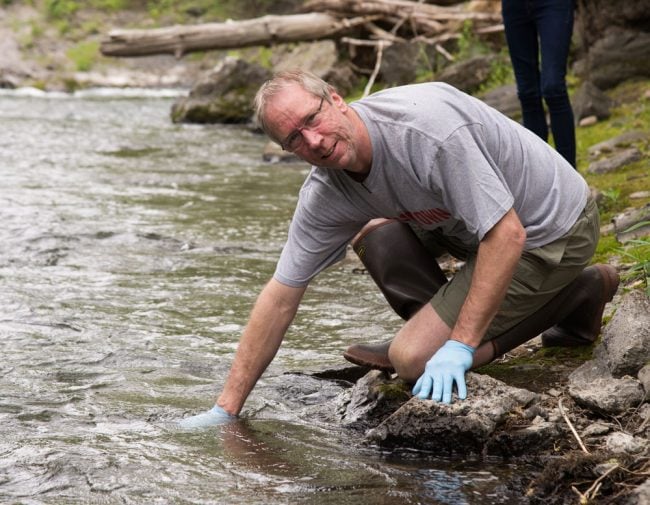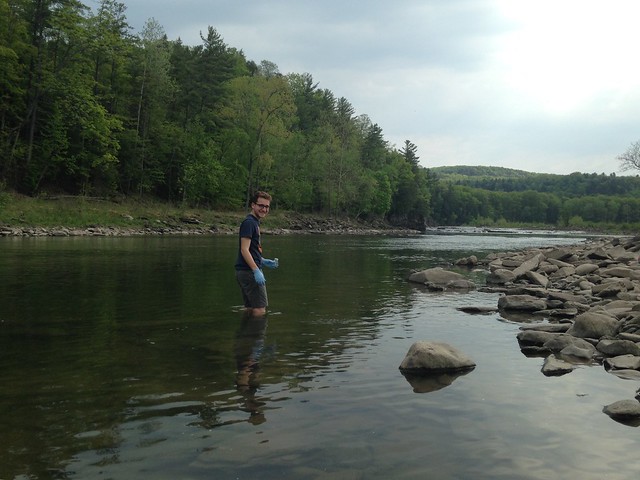In May, expanded monitoring finds water fit for swimming in many places

Martin Overington samples the Roeliff Jansenkill in May 2016. (Photo by Kaare Christian / Roe Jan Watershed Association)
View more images on our Flickr site

Martin Overington samples the Roeliff Jansenkill in May 2016. (Photo by Kaare Christian / Roe Jan Watershed Association)
In May 2016, Riverkeeper and our partners took water samples at 325 locations, and together, we will make over 1,100 measures of water quality. It’s our biggest month of sampling to date, and the first to sample so many locations, spanning over 600 river miles, in such a short period of time. All samples were taken within 12 days, and nearly 300 sample sites were sampled within a single week, spanning the headwaters of tributaries in Rome, NY; Sparta, NJ; and Hillsdale, NY, to the Gowanus Canal in New York City.
Samples taken from many locations showed water quality that met U.S. Environmental Protection Agency (EPA) guidelines for safe swimming. This makes sense, given that little rain has fallen across the region. Contrast the results with May 2011, when heavy rain fell prior to sampling, and you see how water becomes contaminated when rain causes sewers to overflow, and pollution to cascade off streets and farms. The change in water quality is dramatic, and points to one overarching lesson we’ve learned in nearly 10 years of water quality sampling: Allowing rain to infiltrate into the ground, rather than run off into streams, is essential to meeting the Clean Water Act goal of making water safe for swimming.
Check out the latest data, and remember that the data shows a snapshot in time, and doesn’t indicate water quality today:
- Hudson River Estuary
- Mohawk River
- Catskill Creek
- Roeliff Jansen Kill
- Esopus Creek
- Saw Kill
- Rondout Creek
- Wallkill River
- Ossining Beach
- Pocantico River
- Sparkill Creek
- Saw Mill River
- New York City
Also check out this Time Warner Cable report about community sampling of the Saw Kill.
In May, we launched new projects to sample the Roeliff Jansen Kill (the “Roe Jan”) and the Saw Kill, in partnership with the Bard Water Lab, the Roe Jan Watershed Association and the Saw Kill Watershed Community. We expanded sampling on the Mohawk River, in partnership with SUNY Cobleskill. We expanded our partnership with The Sarah Lawrence College Center for the Urban River at Beczak, where samples from the Sparkill Creek and Pocantico River will now be processed, along with those of the Saw Mill River. And we processed our first 100 samples at the Hudson River Port lab at the Hudson River Maritime Museum in Kingston.
Finally, to get insights into the pharmaceuticals, personal care products and pesticides in our waters, we took additional samples from the Hudson River, Wallkill River and Rondout Creek in support of partner projects with CUNY Queens College, Columbia University’s Lamont-Doherty Earth Observatory, Cornell University and the EPA.
Look for updates on all these projects as the season continues.
Thank you
Nearly three dozen partners make the collection and processing of data possible. In 2016, financial support for Riverkeeper’s Water Quality Program and some of the key partners that collect or process data presented here comes from:
The Leon Lowenstein Foundation, the NYS Environmental Protection Fund (via grants from the Department of Environmental Conservation’s Hudson River Estuary and Mohawk River Basin Programs), CUNY Queens College, Columbia University’s Lamont-Doherty Earth Observatory, the Hudson River Improvement Fund, HSBC, IDEXX, JSA Financial, SUNY Cobleskill, Cornell University’s Water Resources Institute, Bard Water Lab, Columbia-Greene Trout Unlimited, New York City Water Trail Association and its partners, Center for the Urban River at Beczak, Westchester Community Foundation, Barra & Trumbore, Ossining High School, and many Riverkeeper members.


